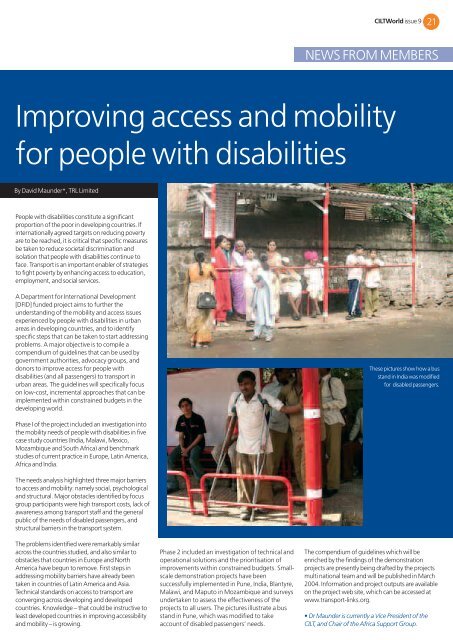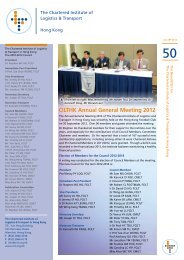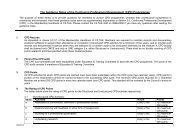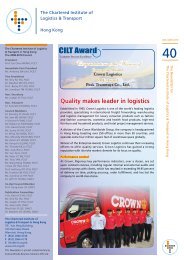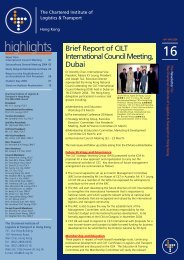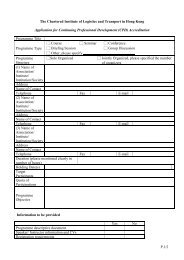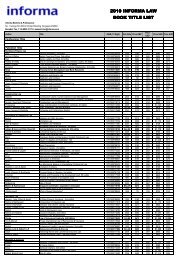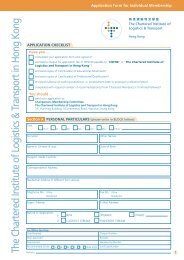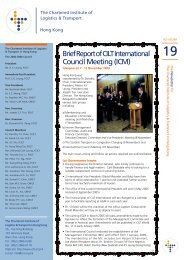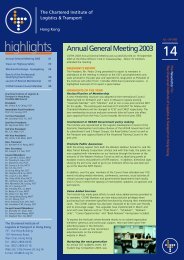CIT WORLD 8 TEMPLATE - The Chartered Institute of Logistics and ...
CIT WORLD 8 TEMPLATE - The Chartered Institute of Logistics and ...
CIT WORLD 8 TEMPLATE - The Chartered Institute of Logistics and ...
You also want an ePaper? Increase the reach of your titles
YUMPU automatically turns print PDFs into web optimized ePapers that Google loves.
People with disabilities constitute a significant<br />
proportion <strong>of</strong> the poor in developing countries. If<br />
internationally agreed targets on reducing poverty<br />
are to be reached, it is critical that specific measures<br />
be taken to reduce societal discrimination <strong>and</strong><br />
isolation that people with disabilities continue to<br />
face. Transport is an important enabler <strong>of</strong> strategies<br />
to fight poverty by enhancing access to education,<br />
employment, <strong>and</strong> social services.<br />
A Department for International Development<br />
[DFID] funded project aims to further the<br />
underst<strong>and</strong>ing <strong>of</strong> the mobility <strong>and</strong> access issues<br />
experienced by people with disabilities in urban<br />
areas in developing countries, <strong>and</strong> to identify<br />
specific steps that can be taken to start addressing<br />
problems. A major objective is to compile a<br />
compendium <strong>of</strong> guidelines that can be used by<br />
government authorities, advocacy groups, <strong>and</strong><br />
donors to improve access for people with<br />
disabilities (<strong>and</strong> all passengers) to transport in<br />
urban areas. <strong>The</strong> guidelines will specifically focus<br />
on low-cost, incremental approaches that can be<br />
implemented within constrained budgets in the<br />
developing world.<br />
Phase I <strong>of</strong> the project included an investigation into<br />
the mobility needs <strong>of</strong> people with disabilities in five<br />
case study countries (India, Malawi, Mexico,<br />
Mozambique <strong>and</strong> South Africa) <strong>and</strong> benchmark<br />
studies <strong>of</strong> current practice in Europe, Latin America,<br />
Africa <strong>and</strong> India.<br />
<strong>The</strong> needs analysis highlighted three major barriers<br />
to access <strong>and</strong> mobility: namely social, psychological<br />
<strong>and</strong> structural. Major obstacles identified by focus<br />
group participants were high transport costs, lack <strong>of</strong><br />
awareness among transport staff <strong>and</strong> the general<br />
public <strong>of</strong> the needs <strong>of</strong> disabled passengers, <strong>and</strong><br />
structural barriers in the transport system.<br />
<strong>The</strong> problems identified were remarkably similar<br />
across the countries studied, <strong>and</strong> also similar to<br />
obstacles that countries in Europe <strong>and</strong> North<br />
America have begun to remove. First steps in<br />
addressing mobility barriers have already been<br />
taken in countries <strong>of</strong> Latin America <strong>and</strong> Asia.<br />
Technical st<strong>and</strong>ards on access to transport are<br />
converging across developing <strong>and</strong> developed<br />
countries. Knowledge – that could be instructive to<br />
least developed countries in improving accessibility<br />
<strong>and</strong> mobility – is growing.<br />
Phase 2 included an investigation <strong>of</strong> technical <strong>and</strong><br />
operational solutions <strong>and</strong> the prioritisation <strong>of</strong><br />
improvements within constrained budgets. Smallscale<br />
demonstration projects have been<br />
successfully implemented in Pune, India, Blantyre,<br />
Malawi, <strong>and</strong> Maputo in Mozambique <strong>and</strong> surveys<br />
undertaken to assess the effectiveness <strong>of</strong> the<br />
projects to all users. <strong>The</strong> pictures illustrate a bus<br />
st<strong>and</strong> in Pune, which was modified to take<br />
account <strong>of</strong> disabled passengers’ needs.<br />
CILTWorld issue 9 21<br />
NEWS FROM MEMBERS<br />
Improving access <strong>and</strong> mobility<br />
for people with disabilities<br />
By David Maunder*, TRL Limited<br />
<strong>The</strong>se pictures show how a bus<br />
st<strong>and</strong> in India was modified<br />
for disabled passengers.<br />
<strong>The</strong> compendium <strong>of</strong> guidelines which will be<br />
enriched by the findings <strong>of</strong> the demonstration<br />
projects are presently being drafted by the projects<br />
multi national team <strong>and</strong> will be published in March<br />
2004. Information <strong>and</strong> project outputs are available<br />
on the project web site, which can be accessed at<br />
www.transport-links.org.<br />
• Dr Maunder is currently a Vice President <strong>of</strong> the<br />
CILT, <strong>and</strong> Chair <strong>of</strong> the Africa Support Group.


